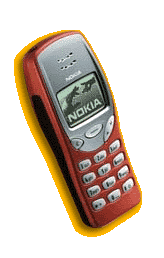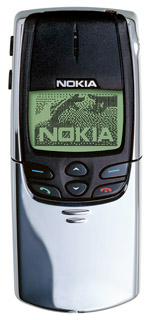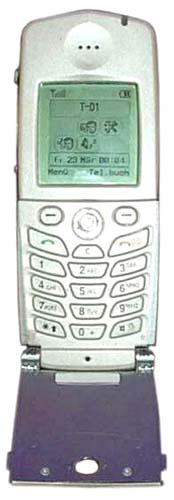|
|
The second myth. External aerial provides best reception?!

Mobile phones with internal aerial have attractive appearance, they are convenient for carrying in pocket of jeans or trousers, in fact they do not have obtrusive parts, and, that is important, it's impossible to break off the aerial, it is reliably hidden in the case. The majority of users, nevertheless, consider, that such devices concede to their fellows with external aerials by sensitivity. In many respects such opinion is only a prejudice of the inhabitant, to which it’s difficult to change his conceptions and habits. It is necessary to search for roots of this judgment in the first models of cellular telephones which had external sliding aerial, it were phones which worked in analog standards, such as NMT or AMPS. For a long time standards of cellular communication has changed, now in the most part of Europe GSM standard is extended and for mobile terminals became technically possible the use of internal aerials .

The first company, which introduced internal aerials, became Finnish Nokia, applied it in Nokia 8810 model. The model was oriented on prosperous buyers and has not been widely distributed. Already in mass model Nokia 3210 users could understand advantages of the built-in aerial. Due to attractive design, an opportunity of front panels change Nokia 3210 practically right after the output became the most popular model in its price class, its sales grew constantly. Not in the last order such success has been caused by the absence of the external fixed aerial. As practice has shown, Nokia 3210 did not concede on sensitivity to devices of its class, equipped with the external aerial. The primary competitor for this model was Siemens C25 phone, which also was extremely popular, had the external aerial and thus quite comparable with 3210 sensitivity.
Other manufacturers did not have models capable to compete on equal with 3210, and the basic players have joined in race for phones with the internal aerial. As has shown Nokia's experience, devices with the internal aerial have only some lacks. First, the sensitivity of phone during talking sharply reduces if to cover the aerial with hand. The situation is improbable as the internal aerial settles down at the top of the case, but it is possible. Since then instructions for phones are equipped with the recommendation, not to hold phone during talking by the top as it worsens its characteristics. The second problem was more serious, and till now is not solved up to the end. At falling and rather strong blow the internal aerial can receive insignificant damages which negatively influence its characteristics. Diagnosing of similar malfunctions is practically impossible even in the service centers, that increases cost of warranty service and probable repair for the manufacturer.

Because of the second problem in the market has not appeared multitude of phones with the internal aerial from competitors of Nokia Company. Already in the subsequent models (8210, 8850) to Nokia it was possible to lower possible consequences of blow on the internal aerial and to reduce possible problems to the minimum. Despite of it 8810 model, previous to 8850 was extremely unsuccessful, it had burning out transmitter that had been connected with the aerial problems. Further there were no similar problems with no one of devices and today the technical decision of the internal aerial system from Nokia is protected by several patents. Therefore the competing companies have gone in other way.
So, Siemens Company for the first time used the internal aerial in M35 phone which is analogue of C35i. Under the characteristics these two models are extremely similar, the basic difference consists in the type of the aerial and in protective rubber covering, which is applied in М35 model. Besides damp-proof case, rubber which is covering М35 plays paddy role in phone falling, thus, protects the aerial from damages. As you can see, Siemens Company was not mistaken too, having used other method, М35 was deservedly popular. There was no difference on sensitivity between С35 and М35 and is not present, models are absolutely identical.
That was quite suitable for youth models, Nokia 3210 and Siemens M35, or for fashion devices as Nokia 8210 and 8850 could not suit for business phones. In fact the business users are conservative and thus are very exacting concerning the quality of communication and phone opportunities. As the researches have shown, many businessmen did not consider phone without aerial as a serious device (more precisely with the internal aerial, but it was spoken as if it is not present at all). The results of interrogations were depressing, business segment was not ready to accept phone with built-in aerial. It seemed that it is not worth to try but, nevertheless, Nokia risked and won. The model Nokia 6210 came on change to one of the most popular business devices, namely 6150 has been unanimously recognized as one of the most successful novelties. In the phone as against the previous models there were no basic innovations; here engineers collected all the best of all model lines. Thus there are a little who knows, that there were samples of Nokia 6210 design with the external aerial, but they have been rejected, because the interrogations in focus groups have shown, that the design with the absent external aerial is more attractive. It is interesting, that focus groups were generated in Italy where users not only understand fashion, but sensitively react to any changes. It is considered, that if Italians approve the design, more likely, it will be hospitably accepted all over the world.
Designers and experts in marketing of Nokia Company were not mistaken; the Nokia 6210 model became very popular and broke stereotypes of business class phone users. Besides Nokia 6210, Siemens S35 model appeared by the moment, that was also focused on the business segment. These two models proved, that business devices can have internal aerial and thus not concede on quality of communication at all.
To understand as far as the pressure of stereotypes is great it is necessary to mention one remarkable fact. Many phones which are made for American market are supplied with the aerial plaster cast which plays a psychological role. The user, extending the aerial, subconsciously waits for communication improvement, and actually this action does not play any role. Manufacturers in this case are compelled to go on occasion of users, and inertia of thinking of the last ones is great. To the ambassador of success Nokia 3210 and 6210 all phone line has in-built aerials.

Strangely enough, but intermediate variants between phones with the external or internal aerial are also possible. An example of it showed Samsung, having released on the market the SGH-N400 model. This business device has output forward external aerial which standby mode is hidden inside the device. Thus, this phone simultaneously combines attractive appearance, convenience to use, and also satisfies stereotypes of users. By the way, the aerial in N400 is put forward as automatically with flip opening or number dialing, and manually as well.
Other grandee, in particular Motorola, did not hasten with the announcement of model with the internal aerial. It can be explained simply, within the last three years the company developed essentially new design of the internal aerial and in the beginning of this year has finished it. According to statements of company engineers, the internal aerial from Motorola on sensitivity is comparable with external aerials, does not deliver problems with repairing and is protected from shock loadings. The system of the aerial is protected by several patents. For the first time it is applied in the model of bottom price range, Motorola T192, cost from 120 up to 140 dollars (at the moment of the output). If in Motorola T192 had been applied the external aerial its weight would have been on 20 gramme less so it is necessary to pay for convenience by weight of the device.
Other phone manufacturer, Panasonic Company for the first time has presented the internal aerial in GD75. The device concerns to the fashion class, has a lot of functions, many of them are similar to those that are included in GD92, GD93 models...
Finishing the article, it would be desirable to emphasize once again, that there is no difference in sensitivity of phones with the built-in or external aerial. As practice shows, they are phones of one class, and they work approximately equally. Thus, the type of the aerial in modern phone should not influence on your choice, in fact under the characteristics they are identical. Now we notice practically mass transition from external aerials, to built-in internal.
Eldar Murtazin ([email protected])
Translated by Andreas Von Horn ([email protected])
Published — 24 April 2003
Have something to add?! Write us... [email protected]
|
News:
[ 31-07 16:21 ]Sir Jony Ive: Apple Isn't In It For The Money
[ 31-07 13:34 ]Video: Nokia Designer Interviews
[ 31-07 13:10 ]RIM To Layoff 3,000 More Employees
[ 30-07 20:59 ]Video: iPhone 5 Housing Shown Off
[ 30-07 19:12 ]Android Fortunes Decline In U.S.
[ 25-07 16:18 ]Why Apple Is Suing Samsung?
[ 25-07 15:53 ]A Few Choice Quotes About Apple ... By Samsung
[ 23-07 20:25 ]Russian iOS Hacker Calls It A Day
[ 23-07 17:40 ]Video: It's Still Not Out, But Galaxy Note 10.1 Gets An Ad
[ 19-07 19:10 ]Another Loss For Nokia: $1 Billion Down In Q2
[ 19-07 17:22 ]British Judge Orders Apple To Run Ads Saying Samsung Did Not Copy Them
[ 19-07 16:57 ]iPhone 5 To Feature Nano-SIM Cards
[ 18-07 14:20 ]What The iPad Could Have Looked Like ...
[ 18-07 13:25 ]App Store Hack Is Still Going Strong Despite Apple's Best Efforts
[ 13-07 12:34 ]Infographic: The (Hypothetical) Sale Of RIM
[ 13-07 11:10 ]Video: iPhone Hacker Makes In-App Purchases Free
[ 12-07 19:50 ]iPhone 5 Images Leak Again
[ 12-07 17:51 ]Android Takes 50%+ Of U.S. And Europe
[ 11-07 16:02 ]Apple Involved In 60% Of Patent Suits
[ 11-07 13:14 ]Video: Kindle Fire Gets A Jelly Bean
Subscribe
|


